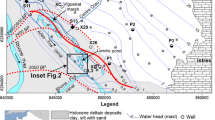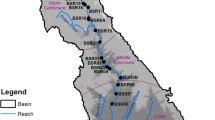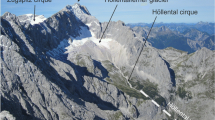Abstract
Two test cases from Israel are presented herein employing the decay rate of radon along the flow path to assess groundwater flow velocities. Groundwater flow reaching the fault zone emerges in several places along the rift fault zone as thermal springs because of deep water confinement. The high water temperature of the surface is indicative of high vertical flow velocities, which maintains the original high temperatures. Knowing the Rn content at a source point and at a given down-gradient, and assuming no Rn addition from the water itself or along the flow path, one can calculate the flow velocity based on the Rn half-life time. The decay of Rn in western Galilee was found to be ∼570–150 pCi/l, and in the Dead Sea area from 5000–2000 pCi/l along a respective flow path of 1000 and 200 m, Based on the above, the calculated flow velocities were compared with those obtained from pumping tests in the study area. The method is applicable, because of the short Rn half-life, to cases of high Rn contents, short distances and high flow velocities.
Similar content being viewed by others
Author information
Authors and Affiliations
Additional information
Received: 18 January 2000 · Accepted: 21 March 2000
Rights and permissions
About this article
Cite this article
Kafri, U. Radon in groundwater as a tracer to assess flow velocities: two test cases from Israel. Environmental Geology 40, 392–398 (2001). https://doi.org/10.1007/s002540000164
Issue Date:
DOI: https://doi.org/10.1007/s002540000164




